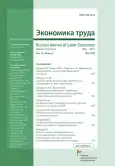Digital transformation and unemployment: how to reconcile technological progress and employment
- 作者: Veshkurova A.B.1, Terganov Y.K.2
-
隶属关系:
- The Financial University under the Government of the Russian Federation
- Academy of Labour and Social Relations
- 期: 卷 10, 编号 5 (2023)
- 页面: 665-684
- 栏目: Articles
- URL: https://journals.eco-vector.com/2410-1613/article/view/607787
- DOI: https://doi.org/10.18334/et.10.5.117777
- ID: 607787
如何引用文章
详细
The article discusses the need to combine technological progress and employment by introducing appropriate regulatory mechanisms and educational programs aimed at improving skills and developing new professional skills.The authors conclude that digital transformation not only does not increase the risks of mass unemployment, but on the contrary contributes to the growth of labor productivity. Those countries that maintain a leading position in the labor market with the help of automation overcome the shortage of labor resources and also improve the quality of products. However, automation increases the demand for digital skills, so it is necessary to increase the share of digital professions and specialties as part of vocational training programs.The article also describes various approaches to vocational training depending on age with an emphasis on the development of cross-functionality and increasing opportunities for career growth. The authors also emphasize that artificial intelligence should be used in combination with human expertise to determine the optimal trajectory of a person's professional development.The article may be of interest to representatives of employment services, as well as researchers in the field of labor market and employment.
作者简介
Alina Veshkurova
The Financial University under the Government of the Russian Federation
Email: veshenka@bk.ru
Yaroslav Terganov
Academy of Labour and Social Relations
Email: yatmail@gmail.com
参考
- Активность найма на IT-рынке в октябре 2022. Habr.com. [Электронный ресурс]. URL: https://habr.com/ru/company/habr_career/blog/697792/ (дата обращения: 05.04.2023).
- Абрамкина Д.А. Структурная безработица как индикатор несогласованности спроса и предложения на рынке труда: профессионально-квалификационный аспект // Вестник НГИЭИ. – 2020. – № 1(104). – c. 107-116.
- Данные Министерства труда Российской Федерации. Mintrud.gov.ru. [Электронный ресурс]. URL: https://mintrud.gov.ru/docs/mintrud/migration/1324#:~:text=Ожидается%2C%20что%20численность% (дата обращения: 05.04.2023).
- Трудовые ресурсы, занятость и безработица. Данные Федеральной службы государственной статистики Российской Федерации. [Электронный ресурс]. URL: https://rosstat.gov.ru/labour_force (дата обращения: 05.04.2023).
- Предположительная численность населения Российской Федерации. Данные Федеральной службы государственной статистики Российской Федерации. [Электронный ресурс]. URL: https://rosstat.gov.ru/compendium/document/13285 (дата обращения: 06.04.2023).
- Национальные счета. Данные Федеральной службы государственной статистики Российской Федерации. [Электронный ресурс]. URL: https://rosstat.gov.ru/statistics/accounts (дата обращения: 05.04.2023).
- Данные The International Federation of Robotics. Ifr.org. [Электронный ресурс]. URL: https://svspb.net/sverige/statistika-stran-mira.php (дата обращения: 02.04.2023).
- Кашепов А.В., Афонина К.В., Головачёв Н.В. Рынок труда РФ в 2020–2021 гг.: безработица и структурные изменения // Социально-трудовые исследования. – 2021. – № 2(43). – c. 33-44. – doi: 10.34022/2658-3712-2021-43-2-33-44.
- Корж Н.В., Шкатова К.В., Супиков В.Н. Современные тенденции развития российского рынка труда // Известия высших учебных заведений. Поволжский регион. Общественные науки. – 2022. – № 2(62). – c. 40-51. – doi: 10.21685/2072-3016-2022-2-4.
- Купрещенко Н.П. Безработица как внутренняя угроза экономического развития и повышения качества жизни граждан России // Вестник экономической безопасности. – 2022. – № 6. – c. 292-298. – doi: 10.24412/2414-3995-2022-6-292-298.
- Рейтинг российских регионов по уровню безработицы. Ria.ru. [Электронный ресурс]. URL: https://ria.ru/20230227/bezrabotitsa-1853624257.html (дата обращения: 05.04.2023).
- Росстат оценил спад ВВП РФ в 2022 году в 2,1%. Interfax.ru. [Электронный ресурс]. URL: https://www.interfax.ru/business/887045 (дата обращения: 02.04.2023).
- Рогова Т.М., Дубская О.С., Ревунов С.В. Основные демографические тенденции и кадровый потенциал экономики РФ в современных условиях // Московский экономический журнал. – 2022. – № 6. – doi: 10.55186/2413046X_2022_7_6_366.
- Топилин А.В., Воробьева О.Д., Максимова А.С. Воспроизводство трудового потенциала в период депопуляции 2019-2035 гг. И компенсирующая роль миграционного фактора // Статистика и Экономика. – 2019. – № 5. – c. 70-84. – doi: 10.21686/2500-3925-2019-5-70-84.
- Эксперты назвали самые востребованные профессии в России в 2023 году. Sib.fm. [Электронный ресурс]. URL: https://sib.fm/news/2023/01/25/eksperty-nazvali-samye-vostrebovannye-professii-v-rossii-v-2023-godu- (дата обращения: 06.04.2023).
- Kuznetsova A., Selezneva A., Askarov A., Askarova A., Gusmanov R. Trends of Labor Market Change in the Countries of the European Union and Russia under Conditions of Digitalization of the Economy // Montenegrin Journal of Economics. – 2021. – № 1. – p. 175-183. – doi: 10.14254/1800-5845/2021.17-1.13.
- Piroșcă, Grigore Ioan, George Laurențiu Șerban-Oprescu, Liana Badea, Mihaela-Roberta Stanef-Puică, Carlos Ramirez Valdebenito Digitalization and Labor Market—A Perspective within the Framework of Pandemic Crisis // Journal of Theoretical and Applied Electronic Commerce Research. – 2021. – № 7. – p. 2843-2857. – doi: 10.3390/jtaer16070156.
- Sarabdeen M., Alofaysan H. Investigating the Impact of Digital Transformation on the Labor Market in the Era of Changing Digital Transformation Dynamics in Saudi Arabia // Economies. – 2023. – № 1. – p. 12. – doi: 10.3390/economies11010012.
- Wang B., Liu Y., Qian J., Parker S.K. Achieving Effective Remote Working during the COVID-19 Pandemic: A Work Design Perspective // Applied Psychology. – 2021. – № 1. – p. 16-59. – doi: 10.1111/apps.12290.
补充文件










